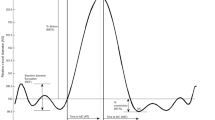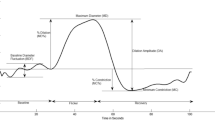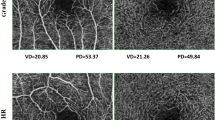Abstract
Early evaluation of cardiovascular (CV) risk in hypertensive patients is of primary importance and studies of retinal vessels can be helpful. The aim of this study is to assess the correlation between retinal vessel changes and target organ damage (TOD), expressed as left ventricular remodelling (LVR) or hypertrophy (LVH). We evaluated 60 treated hypertensive individuals (mean age 60.9±13.3 years). On the basis of echocardiographic results, we divided the subjects showing the presence of TOD and subjects without TOD into Groups A and B, respectively. Both groups underwent a non-mydriatic digital retinography. The obtained vessel images were analysed using dedicated software in order to calculate AVR (arteriovenular ratio), index of the retinal arteriolar narrowing. The data analyses confirmed a mean AVR value of 0.86 in Group B and a mean value of 0.77 in Group A. AVR index was also analysed in a subgroup of A with evidence of LVR, and mean value was 0.76. The same procedure was carried out with subgroup of A with LVH and AVR index resulted 0.77. In all comparisons, P-value was statistically significant (P<0.05). Our findings provide evidence that in hypertensive patients retinal AVR correlates with the presence of TOD, in this study in the context of LVR and LVH. In conclusion, AVR offers a direct vision retinal microcirculation and, also, indirectly, provides information of the left ventricular geometric pattern in hypertensive patients; thus, AVR may have an important role in global CV risk stratification and could possibly be used for optimising the hypertensive patient management.
This is a preview of subscription content, access via your institution
Access options
Subscribe to this journal
Receive 12 digital issues and online access to articles
$119.00 per year
only $9.92 per issue
Buy this article
- Purchase on Springer Link
- Instant access to full article PDF
Prices may be subject to local taxes which are calculated during checkout

Similar content being viewed by others
References
Mancia G, De Backer G, Dominiczak A, Cifkova R, Fagard R, Germano G et al. Guidelines for the Management of Arterial Hypertension: The Task Force for the Management of Arterial Hypertension of the European Society of Hypertension (ESH) and of the European Society of Cardiology (ESC). J Hypertens 2007; 25: 1105–1187.
Kannel WB, Gordon T, Offutt D . Left ventricular hypertrophy by electrocardiogram. Prevalence, incidence, and mortality in the Framingham study. Ann Intern Med 1969; 71 (1): 89–105.
Coca A, Gabriel R, de la Figuera M, Lopez-Sendon JL, Fernandez R, Sagastagoitia JD et al. The impact of different echocardiographic diagnostic criteria on the prevalence of left ventricular hypertrophy in essential hypertension: the VITAE study. Ventriculo Izquierdo Tension Arterial Espana. J Hypertens 1999; 17 (10): 1471–1480.
Ganau A, Devereux RB, Roman MJ, de Simone G, Pickering TG, Saba PS et al. Patterns of left ventricular hypertrophy and geometric remodelling in essential hypertension. J Am Coll Cardiol 1992; 19: 1550–1558.
Cuspidi C, Macca G, Michev I, Fusi V, Severgnini B, Corti C et al. Left ventricular concentric remodelling and extracardiac target organ damage in essential hypertension. J Hum Hypertens 2002; 16 (6): 385–390.
Muiesan ML, Grassi G . Assessment of retinal vascular changes in hypertension: new perspectives. J Hypertens 2006; 24: 813–814.
Cuspidi C, Sala C . Retinal wall-to-lumen ratio: a new marker of endothelial function? J Hypertens 2011; 29: 33–35.
Masaidi M, Cuspidi C, Giudici V, Negri F, Sala C, Zanchetti A et al. Is retinal arteriolar-venular ratio associated with cardiac and extracardiac organ damage in essential hypertension? J Hypertens 2009; 27 (6): 1277–1283.
Cuspidi C, Meani S, Salerno M, Fusi V, Severgnini B, Valerio C et al. Retinal microvascular changes and target organ damage in untreated essential hypertensives. J Hypertens 2004; 22 (11): 2095–2102.
Klein R, Klein BE, Moss SE, Wang Q . Blood pressure, hypertension and retinopathy in a population. Trans Am Ophthalmol Soc 1993; 91: 207–222 discussion 222-6.
Wong TY, Klein R, Klein BE, Tielsch JM, Hubbard L, Nieto FJ . Retinal microvascular abnormalities and their relationship with hypertension, cardiovascular disease, and mortality. Surv Ophthalmol 2001; 46: 59–80.
Grosso A, Rabbia F, Fea A, Grosso T, Grignolo F, Veglio F . Comparison between generalized retinal arteriolar narrowing and left ventricular mass in young untreated hypertensive patients. Blood Press 2006; 15 (5): 308–312.
Wong TY, Knudtson MD, Klein R, Klein BE, Hubbard LD . A prospective cohort study of retinal arteriolar narrowing and mortality. Am J Epidemiol 2004; 159 (9): 819–825.
Dimmitt SB, West JN, Eames SM, Gibson JM, Gosling P, Littler WA . Usefulness of ophthalmoscopy in mild to moderate hypertension. Lancet 1989; 1: 1103–1106.
Dahlof B, Stenkula S, Hansson L . Hypertensive retinal vascular changes: relationship to left ventricular hypertrophy and arteriolar changes before and after treatment. Blood Press 1992; 1 (1): 35–44.
Hubbard LD, Brothers RJ, King WN, Clegg LX, Klein R, Cooper LS et al. Methods for evaluation of retinal microvascular abnormalities associated with hypertension/sclerosis in the Atherosclerosis Risk in Communities Study. Ophthalmology 1999; 106 (12): 2269–2280.
Klein R, Klein BE, Moss SE . The relation of systemic hypertension to changes in the retinal vasculature: the Beaver Dam Eye Study. Trans Am Ophthalmol Soc 1997; 95: 329–348 discussion 348-50.
Klein R, Sharrett AR, Klein BE, Chambless LE, Cooper LS, Hubbard LD et al. Are retinal arteriolar abnormalities related to atherosclerosis? The Atherosclerosis Risk in Communities Study. Arterioscler Thromb Vasc Biol 2000; 20 (6): 1644–1650.
Wong TY, Klein R, Sharrett AR, Duncan BB, Couper DJ, Klein BE et al. Retinal arteriolar diameter and risk for hypertension. Ann Intern Med 2004; 140: 248–255.
Sharrett AR, Hubbard LD, Cooper LS, Sorlie PD, Brothers RJ, Nieto FJ et al. Retinal arteriolar diameters and elevated blood pressure: the Atherosclerosis Risk in Communities Study. Am J Epidemiol 1999; 150 (3): 263–270.
Sega R, Cesana G, Bombelli M, Grassi G, Stella ML, Zanchetti A et al. Seasonal variations in home and ambulatory blood pressure in the PAMELA population. Pressione Arteriose Monitorate E Loro Associazioni. J Hypertens 1998; 16 (11): 1585–1592.
Modesti PA, Morabito M, Bertolozzi I, Massetti L, Panci G, Lumachi C et al. Weather-related changes in 24-hour blood pressure profile: effects of age and implications for hypertension management. Hypertension 2006; 47: 155–161.
O'Brien E, Asmar R, Beilin L, Imai Y, Mallion JM, Mancia G et al. European Society of Hypertension recommendations for conventional, ambulatory and home blood pressure measurement. J Hypertens 2003; 21 (5): 821–848.
Mancia G, Sega R, Bravi C, De Vito G, Valagussa F, Cesana G et al. Ambulatory blood pressure normality: results from the PAMELA study. J Hypertens 1995; 13 (12 Pt 1): 1377–1390.
Grundy SM, Cleeman JI, Daniels SR, Donato KA, Eckel RH, Franklin BA et al. Diagnosis and management of the metabolic syndrome: an American Heart Association/National Heart, Lung, and Blood Institute Scientific Statement. Circulation 2005; 112: 2735–2752.
Expert Panel on Detection, Evaluation, and Treatment of High Blood Cholesterol in Adults. Executive Summary of The Third Report of The National Cholesterol Education Program (NCEP) Expert Panel on Detection, Evaluation, And Treatment of High Blood Cholesterol In Adults (Adult Treatment Panel III). JAMA 2001; 285: 2486–2497.
Gersh BJ, Maron BJ, Bonow RO, Dearani JA, Fifer MA, Link MS et al. 2011 ACCF/AHA guideline for the diagnosis and treatment of hypertrophic cardiomyopathy: executive summary: a report of the American College of Cardiology Foundation/American Heart Association Task Force on Practice Guidelines. Circulation 2011; 124: 2761–2796.
Devereux RB, Reichek N . Echocardiographic determination of left ventricular mass in man. Anatomic validation of the method. Circulation 1977; 55 (4): 613–618.
Hammond IW, Devereux RB, Alderman MH, Lutas EM, Spitzer MC, Crowley JS et al. The prevalence and correlates of echocardiographic left ventricular hypertrophy among employed patients with uncomplicated hypertension. J Am Coll Cardiol 1986; 7 (3): 639–650.
Wong TY, Islam FM, Klein R, Klein BE, Cotch MF, Castro C et al. Retinal vascular caliber, cardiovascular risk factors, and inflammation: the multi-ethnic study of atherosclerosis (MESA). Invest Ophthalmol Vis Sci 2006; 47: 2341–2350.
Wong TY, McIntosh R . Hypertensive retinopathy signs as risk indicators of cardiovascular morbidity and mortality. Br Med Bull 2005; 73-74: 57–70.
Stolk RP, Vingerling JR, de Jong PT, Dielemans I, Hofman A, Lamberts SW et al. Retinopathy, glucose, and insulin in an elderly population. The Rotterdam Study. Diabetes 1995; 44 (1): 11–15.
Parr JC, Spears GF . General caliber of the retinal arteries expressed as the equivalent width of the central retinal artery. Am J Ophthalmol 1974; 77 (4): 472–477.
Parr JC, Spears GF . Mathematic relationships between the width of a retinal artery and the widths of its branches. Am J Ophthalmol 1974; 77 (4): 478–483.
van den Born BJ, Hulsman CA, Hoekstra JB, Schlingemann RO, van Montfrans GA . Value of routine funduscopy in patients with hypertension: systematic review. BMJ 2005; 331: 73.
Cuspidi C, Salerno M, Salerno DE, Meani S, Valerio C, Esposito A et al. High prevalence of retinal vascular changes in never-treated essential hypertensives: an inter- and intra-observer reproducibility study with non-mydriatic retinography. Blood Press 2004; 13 (1): 25–30.
Author information
Authors and Affiliations
Corresponding author
Ethics declarations
Competing interests
The authors declare no conflicts of interest.
Rights and permissions
About this article
Cite this article
Meazza, R., Scardino, C., Grosso Di Palma, L. et al. Target organ damage in hypertensive patients: correlation between retinal arteriovenular ratio and left ventricular geometric patterns. J Hum Hypertens 28, 274–278 (2014). https://doi.org/10.1038/jhh.2013.69
Received:
Revised:
Accepted:
Published:
Issue Date:
DOI: https://doi.org/10.1038/jhh.2013.69
Keywords
This article is cited by
-
Association of serum transforming growth factor β1 with left ventricular hypertrophy in children with primary hypertension
European Journal of Pediatrics (2023)
-
Comparisons of microvascular and macrovascular changes in aldosteronism-related hypertension and essential hypertension
Scientific Reports (2017)



